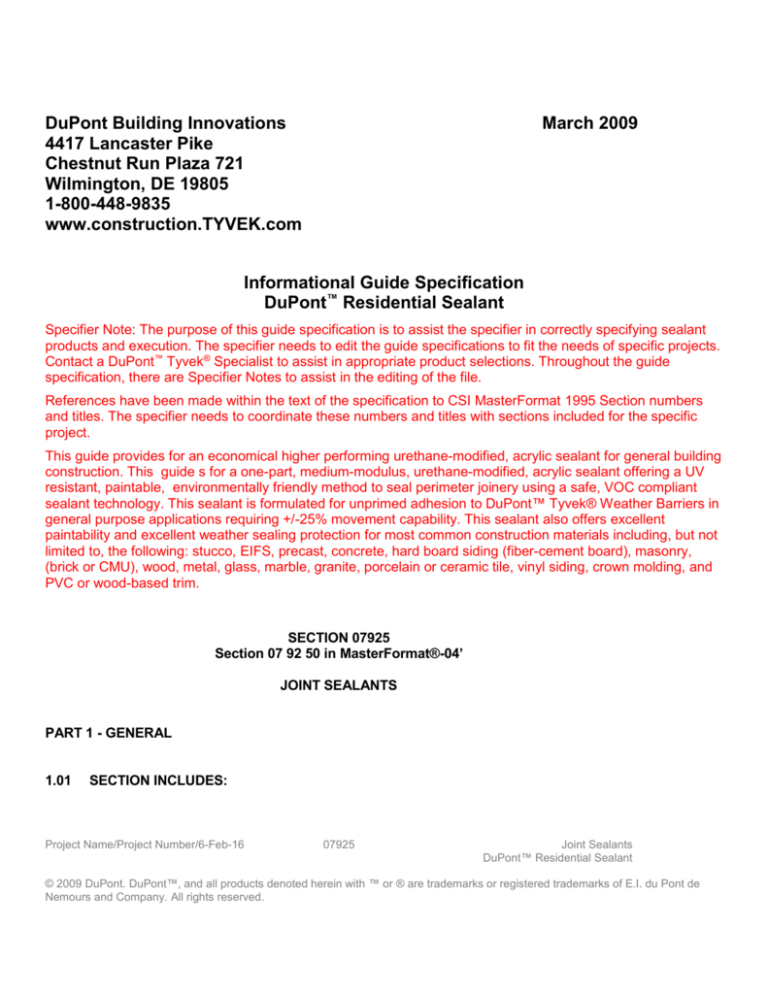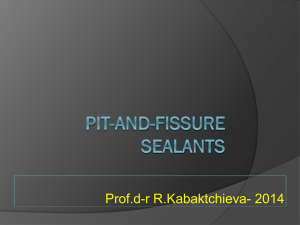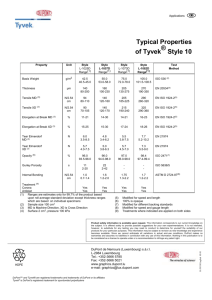
DuPont Building Innovations
4417 Lancaster Pike
Chestnut Run Plaza 721
Wilmington, DE 19805
1-800-448-9835
www.construction.TYVEK.com
March 2009
Informational Guide Specification
DuPont™ Residential Sealant
Specifier Note: The purpose of this guide specification is to assist the specifier in correctly specifying sealant
products and execution. The specifier needs to edit the guide specifications to fit the needs of specific projects.
Contact a DuPont™ Tyvek® Specialist to assist in appropriate product selections. Throughout the guide
specification, there are Specifier Notes to assist in the editing of the file.
References have been made within the text of the specification to CSI MasterFormat 1995 Section numbers
and titles. The specifier needs to coordinate these numbers and titles with sections included for the specific
project.
This guide provides for an economical higher performing urethane-modified, acrylic sealant for general building
construction. This guide s for a one-part, medium-modulus, urethane-modified, acrylic sealant offering a UV
resistant, paintable, environmentally friendly method to seal perimeter joinery using a safe, VOC compliant
sealant technology. This sealant is formulated for unprimed adhesion to DuPont™ Tyvek® Weather Barriers in
general purpose applications requiring +/-25% movement capability. This sealant also offers excellent
paintability and excellent weather sealing protection for most common construction materials including, but not
limited to, the following: stucco, EIFS, precast, concrete, hard board siding (fiber-cement board), masonry,
(brick or CMU), wood, metal, glass, marble, granite, porcelain or ceramic tile, vinyl siding, crown molding, and
PVC or wood-based trim.
SECTION 07925
Section 07 92 50 in MasterFormat®-04’
JOINT SEALANTS
PART 1 - GENERAL
1.01
SECTION INCLUDES:
Project Name/Project Number/6-Feb-16
07925
Joint Sealants
DuPont™ Residential Sealant
© 2009 DuPont. DuPont™, and all products denoted herein with ™ or ® are trademarks or registered trademarks of E.I. du Pont de
Nemours and Company. All rights reserved.
A. Provide Sealant for exterior or interior perimeter, expansion and control joints as indicated, including
substrate preparation, sealant installation and clean up of related installations.
(Specifier Note: Edit to suit each new product specified.)
B. Related Sections:
1. Section 04210:
Unit Masonry Construction
2. Section 07270:
Air Barriers
3. Section 07240:
EIFS - Exterior Insulation and Finish Systems.
4. Section 08910:
Metal Framed Curtain-Wall
5. Section 09220:
Portland Cement Plastering and Stucco Systems.
6. Section 09960:
Special Coatings
1.02 REFERENCES
A. ASTM International
1. ASTM-C 920; Standard Specification for Elastomeric Joint Sealants
2. ASTM C1193; Standard Guide for Use of Joint Sealants
B. FEDERAL SPECIFICATION
1. TT-S-00230C, Type S, Class A
C. American Architectural Manufacturers Association
1. AAMA 803.3, Sealant Compliance
1.03
SUBMITTALS
A. Refer to Section 01330 for submittal procedures and USGBC LEED® qualification information.
B. U.S. Green Building Counsel Leadership in Energy and Environmental Design ( USGBC LEED®): The
USGBC LEED® Green Building Rating System is a voluntary, consensus-based national standard for
developing high-performance sustainable buildings.
(Specifier Note: Edit for USGBC LEED® requirements to suit the specific project. Only low-VOC sealants qualify
for interior use.)
C. Product Data: Submit sealant manufacturer’s most current technical product data indicating compliance
with specified requirements and installation instructions for type of sealant specified.
D.
Quality Control Submittals:
1. Pre-Installation Conference: Submit report verifying project site conditions and mock-up acceptance
prior to installation, including any special requirements as applicable.
2. Installation Schedule: Submit an installation schedule with sequence of sealant placement and
various types of joint sealants required per area as required.
Project Name/Project Number/6-Feb-16
07925
Joint Sealants
DuPont™ Residential Sealant
© 2009 DuPont. DuPont™, and all products denoted herein with ™ or ® are trademarks or registered trademarks of E.I. du Pont de
Nemours and Company. All rights reserved.
E.
1.03
Contract Closeout Submittals: Refer to Section 01780 for Closeout Submittal information.
1. Warranty: Manufacturer's standard 10 year limited product warranty.
QUALITY ASSURANCE
(Specifier Note: Quality Assurance procedures can be obtained from your local DuPont™ Tyvek® Specialist.
They are also accessible at www.construction.tyvek.com.)
A. Installer Qualifications: Installer to comply with quality assurance articles referenced in ASTM C-1193 for
installation of residential sealants.
B. Pre-Construction Mock-Up: Install mock-up prior to installation using acceptable residential joint sealants
including surface preparation per sealant manufacturer's instructions. Obtain Architect/Engineer/Consultant
or Owner’s approval of joint treatments to establish adhesion, appearance and workmanship standard.
(Specifier Note: Edit below mock-up description, size, etc. to suit each project.)
1. Mock-Up Size: Five (5) feet by Five (5) feet or ____ LF of joint sealant
2. Mock-Up Substrate: __________ vertical surfaces as agreed to prior to Mock-up installation.
3. Maintain mock-up during construction for workmanship standard.
4. Mock-up to be incorporated into final construction upon Architect/Engineer/Consultant/Owner’s
written approval
1.04
DELIVERY, STORAGE AND HANDLING
A. Deliver, store, handle, and protect all products in accordance with Section 01600, Product Requirements.
B. Comply with manufacturer's ordering instructions and lead-time(s) required to avoid construction delays.
C. Deliver residential sealant materials in manufacturer's original, unopened, undamaged containers with
identification labels clearly intact.
D. Store and protect residential sealant material containers from harmful weather conditions as recommended
by sealant manufacturer. Protect from damage during construction and while stored onsite. Store joint
sealant materials at temperatures recommended by sealant manufacturer.
1.05
PROJECT CONDITIONS
A. Environmental Requirements: Verify substrates and ambient air temperature at project site before, during
and after application to assure compliance with manufacturer’s recommendations. Surfaces shall be frostfree, clean and completely dry at time of installation.
1. Weather Conditions: In accordance with manufacturer's instructions, do not apply sealants in snow,
rain, fog, or mist, or when such conditions are expected. Allow joint surfaces to attain dry conditions
Project Name/Project Number/6-Feb-16
07925
Joint Sealants
DuPont™ Residential Sealant
© 2009 DuPont. DuPont™, and all products denoted herein with ™ or ® are trademarks or registered trademarks of E.I. du Pont de
Nemours and Company. All rights reserved.
2.
1.06
as recommended by manufacturer before sealant application. Apply only when sealant, surface and
air temperatures will remain above freezing. Do not apply on substrates or surfaces that are above
160 degrees F.
Compliance: Follow manufacturer's specific safety, health and environmental recommendations per
most recent Material Safety Data Sheets, technical bulletins and instructions. Handle all solvents in
compliance with applicable EPA, OSHA, and VOC requirements regarding health/safety standards.
WARRANTY
(Specifier Note: Specific project workmanship warranties must be provided by the installer or through a
performance bond. Coordinate with Section 01700 – Contract Closeout, Warranties and Bonds.)
A. Manufacturer's Warranty: Submit manufacturer's standard product warranty at completion.
1. Warranty Areas: _________________________________________________.
(Specifier Note: Use warranty areas for description of work protected and areas of work excluded as required by
project conditions.)
PART 2 - PRODUCTS
(Specifier Note: Product Information is proprietary to DuPont™ Tyvek® AtticWrap™. If additional products are
required for competitive procurement, contact DuPont Building Innovations for assistance.)
2.01
MANUFACTURERS
A. Product Options: Selection of Residential joint sealant material is based upon a proprietary urethanemodified acrylic sealant technology by DuPont Building Innovations. Any request for substitution must be
submitted a minimum of 10 days prior to Bid for written approval by Architect/Engineer/or Consultant.
Request received after this date will not be accepted. Coordinate with Section 01630 Product Substitution
Procedures.
B.
2.02
Approved Manufacturer: DuPont; 4417 Lancaster Pike, Chestnut Run Plaza 728, Wilmington, DE
19805; 1-800-44-TYVEK (8-9835); http://www.construction.tyvek.com
MATERIALS
A. General: Provide residential sealant and backing materials that are compatible under conditions of service
and applications based on mock-up and field-adhesion test results.
B. Residential Grade Joint Sealant: Provide weather-barrier compatible, urethane-modified acrylic residential
sealant for continuous weather sealing installation as indicated. Comply with ASTM C-920 classifications
Project Name/Project Number/6-Feb-16
07925
Joint Sealants
DuPont™ Residential Sealant
© 2009 DuPont. DuPont™, and all products denoted herein with ™ or ® are trademarks or registered trademarks of E.I. du Pont de
Nemours and Company. All rights reserved.
for type, grade, class, and related use exposure and joint substrate conditions as follows:
1. Single-Component, non-sag, medium-modulus, U-V resistant, residential grade joint sealant:
DuPont™ Residential Sealant: Type S (single-component), grade, NS (Non-sag), Class 25 (+/-25%
movement capability per ASTM C-719), uses, NT, M, G, A, and O.
C. Performance Requirements: DuPont™ Residential Sealant:
1. Hardness, ASTM D-661, Shore A = 13 +/-2
2. Tensile Strength, ASTM D-2370 > 150 PSI
3. Elongation, ASTM D-2370 – >800 percent
4. Cyclic Movement, ASTM C-719; 50% (+/-25 percent movement)
5. Low Temperature Flexibility, ASTM C-793; Pass 180 degree bend (1/2”inch mandrel @-15 degrees
F)
6. Peel Strength, ASTM C-794 > 20 PLI
7. VOC (Volatile Organic Compound) < 1.5% by weight or 16 g/l – Meets SCAQMD Rule#1168 and
California Air Resources Board (CARB) VOC regulations as required for interior sealants for
USGBC LEED® rated projects)
2.03
SEALANT ACCESSORIES:
A. General: Provide joint backings, fillers, or primers as recommended by joint sealant manufacturer.
B. Cylindrical Sealant Backings: Provide joint backings that meet ASTM C-1330, Type O (open-cell
polyurethane) or Type B (non-absorbent bi-cellular backing materials with surface skin) sized 25% or
greater than joint opening with proper density to control sealant depth and profile. Follow joint sealant
manufacturer’s recommendations with backing selections for optimum joint sealant performance.
C. Bond-breaker tape: Polyethylene tape or other approved plastic tape as recommended by joint sealant
manufacturer to prevent 3-sided joint adhesion to rigid, in-flexible joint fillers or filet joint surfaces at back of
joint where such adhesion would restrict proper sealant movement or result in sealant failure.
D. Masking tape: Non-staining, non-absorbent and compatible with joint sealants and adjacent surfaces.
E. Primers: Use primers only as recommended by sealant manufacturer where required for adhesion of
sealant to joint substrates indicated and as determined for use from pre-construction mock-up testing.
PART 3 - EXECUTION
3.01
MANUFACTURER'S INSTRUCTIONS
Project Name/Project Number/6-Feb-16
07925
Joint Sealants
DuPont™ Residential Sealant
© 2009 DuPont. DuPont™, and all products denoted herein with ™ or ® are trademarks or registered trademarks of E.I. du Pont de
Nemours and Company. All rights reserved.
A.
3.02
Comply with manufacturer's most recently published product data, including installation instructions,
substrate field mock-up testing, and surface preparation for joint sealant installation.
EXAMINATION
A. Site Verification of Conditions: Examine joints indicated to receive residential sealant and verify joint
substrate conditions are acceptable for installation in accordance with sealant manufacturer's instructions.
Avoid installation until unsatisfactory conditions have been corrected.
1. General: All joint surfaces must be cleaned and totally dry, frost free, and dust free before joint sealant
application begins for optimum performance. Remove all foreign matter and contaminants including
dirt, dust, oil grease, mildew, loose paint, rust, scale or old caulk.
2. Surface Defects and Repairs: New substrates or newly repaired joint surfaces must be allowed to
cure to full-capacity per manufacturer’s recommendations. Joint surfaces must be visibly clean and
dry before installation of sealants or backing materials.
3.03
PREPARATION
A. General: Clean and prepare joint surfaces immediately before installing residential sealant. Protect
adjacent work areas and finished surfaces from damage during sealant installation.
B. Clean porous surfaces by using heavy duty brushing, light abrasive, mechanical abrading or combination
of these methods to produce a clean sound surface for optimum sealant bonding per joint sealant
manufacturer’s recommendations. Provide a dry, dust-free and cleaned substrates for optimum results.
C. Clean non-porous surfaces by using a two-cloth, solvent wipe method as referenced in ASTM C-1193 and
per sealant manufacturer’s instruction. IPA (isopropyl alcohol) may be used in new construction, nonporous joint cleaning and preparation. Use xylene, toluene, or MEK (methyl ethyl ketone) should only be
used for degreasing solvent or for more aggressive cleaning of non-porous surface residue.
D. Rust or scale must be removed. Prepare substrates using abrasive cleaning methods as recommended by
sealant manufacturer prior to sealant installation.
E. Coordinate cleaning and installation to avoid contamination of wet, freshly coated or adjacent finished
surfaces.
3.04
A.
INSTALLATION
General: Comply with residential sealant manufacturer’s installation instructions for applications indicated
unless more stringent project specific instructions or requirements apply. Only apply when joint sealant,
surface and air temperature will remain above freezing. Avoid substrates exceeding 160 degrees F.
Project Name/Project Number/6-Feb-16
07925
Joint Sealants
DuPont™ Residential Sealant
© 2009 DuPont. DuPont™, and all products denoted herein with ™ or ® are trademarks or registered trademarks of E.I. du Pont de
Nemours and Company. All rights reserved.
B.
Install joint sealant backings of type and size required. For EIFS substrates, use only joint sealant
backings that are non-porous, (ASTM C-1330, Type B or C) and sized a minimum of 25% larger than joint
opening. For non-EIFS joinery, install open-cell backer-rod (ASTM C-1330, Type O) as recommended by
joint sealant manufacturer sized a minimum of 25% larger than joint opening.
1. Avoid gaps, twisting, stretching, or puncturing joint sealant backing materials. Place backing materials
into joint opening to provide the uniform sealant depth allowing optimum sealant profile.
2. Install bond-breaker tape behind sealant joints where backer-rod is not feasible. Use to avoid 3-sided
adhesion at backside of sealant joint.
3. Use masking tape as required to protect adjacent finished surfaces prior to joint sealant installation.
C.
Apply residential sealant for continuous weatherproof protection. Vertical joints should be lapped over
horizontal joints. Comply with installation recommendations in ASTM C-1193 for use of residential joint
weather sealing installations. Comply with all sealant manufacturers installation instructions during
installation of residential sealant.
D.
Install residential sealants in proper sequence with installation of backings.
1. Using proper joint sealant dispensing equipment. Place sealants by pushing bead into joint opening to
fully wet-out joint substrates. Fill sealant joint opening to full and proper hourglass configuration.
2. Install providing uniform cross-sectional shapes and depths in relation to joint width for optimum
sealant movement capability per joint sealant manufacturer’s instructions.
E.
Immediately after placing fresh sealant and before skinning or curing begins, tool sealants using metal
spatulas or tools designed for this purpose in accordance with manufacturer’s recommendations. Provide
a smooth uniform sealant finish, eliminating air pockets and ensuring good contact for optimum sealant
adhesion within each side of the joint opening.
1. Provide concave joint configuration as indicated per figure 5-A in ASTM C-1193 unless otherwise
indicated for the project. Dry tooling is recommended. Avoid using soap and solvents for wet-tooling.
2. Remove excess sealant from surfaces adjacent to joint openings using metal spatula, promptly
cleaning any sealant residue from adjacent finished surfaces. Remove masking after joint sealant is
installed.
F.
Allow residential joint sealant to cure for a minimum of 7-14 days before adhesion testing is preformed as
recommended by joint sealant manufacturer. Do not apply solvent-based sealers specified in Section
07190 until full sealant cure period is attained.
G.
Match approved sealant mock-up for uniform finish, and overall aesthetics. Remove, refinish, or re-install
work not in compliance with the Contract Documents.
3.05
FIELD QUALITY CONTROL
Project Name/Project Number/6-Feb-16
07925
Joint Sealants
DuPont™ Residential Sealant
© 2009 DuPont. DuPont™, and all products denoted herein with ™ or ® are trademarks or registered trademarks of E.I. du Pont de
Nemours and Company. All rights reserved.
A. Field-Adhesion Testing: Installer to keep log of sealant installation, recording self preformed fieldadhesion test as needed for the project. Coordinate with Section 01450 – Field Quality Control.
1. Field-Tests: Field test joint sealants in accordance with Method A, Field-Applied Sealant joint Hand
Pull Tab, in Appendix X-1 in ASTM C-1193.
2. Evaluation: For joint sealants that fail to adhere to the substrate, clean, re-install, and then re-test until
optimum results are obtained.
3.06
CLEANING AND PROTECTION
A. Clean excess sealant or sealant residue adjacent to sealant joint installations as the Work progresses.
Avoid damage to adjacent surfaces from harmful removal techniques. Protect finished surfaces beyond
those that have been masked. Remove and replace damaged joint sealants during construction.
B. Remove temporary coverings and masking protection from adjacent work areas upon completion. Remove
construction debris from the project site on a planned and regular basis.
END OF SECTION
DISCLAIMER:
DuPont Building Innovations Guide Specifications have been written as an aid to the professionally qualified
specifier and design professional. The use of this guideline specification requires the sole professional judgment
and expertise of the qualified specifier and design professional to adapt the information to the specific needs for
the building owner and the project, to coordinate with their construction document process, and to meet all the
applicable building codes, regulations and laws. DUPONT EXPRESSLY DISCLAIMS ANY WARRANTY,
EXPRESSED OR IMPLIED, INCLUDING THE WARRANTY OF MERCHANTABILITY OR FITNESS FOR
PARTICULAR PURPOSE OF THIS PRODUCT FOR THE PROJECT.
Please contact your local DuPont™ Tyvek® Specialist at 1-800-44-Tyvek or visit www.construction.tyvek.com
Project Name/Project Number/6-Feb-16
07925
Joint Sealants
DuPont™ Residential Sealant
© 2009 DuPont. DuPont™, and all products denoted herein with ™ or ® are trademarks or registered trademarks of E.I. du Pont de
Nemours and Company. All rights reserved.








